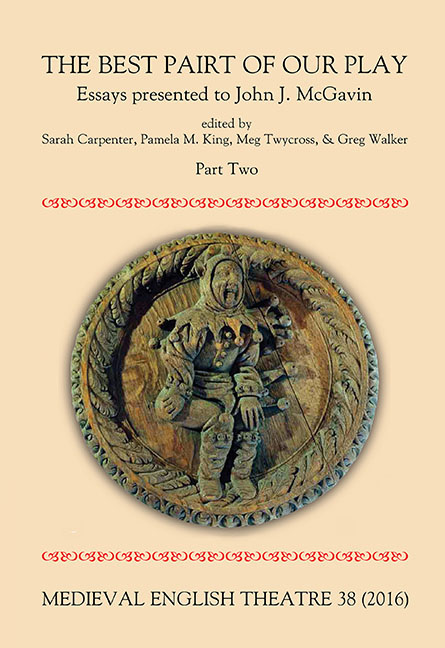 Medieval English Theatre 38
Medieval English Theatre 38 Published online by Cambridge University Press: 20 April 2017
In the collection of the Galleria Nazionale in Rome, in the Barberini Palace, there hangs an Annunciation painting by the Florentine artist Filippo Lippi. The painting has been dated on stylistic evidence alone to 1442: nothing is known of its original location, or of who commissioned or owned it; two figures who must be the donors appear in the bottom right hand of the painting, but they are unidentified. I am not the only medievalist to have observed that the bearded donor bears an historically accidental but nonetheless striking resemblance to John McGavin, for which reason the painting is my chosen starting point for this essay: a more scholarly reason is that the painting provides a study of staging, of spectatorship, and indeed of staging spectatorship — topics which have been so brilliantly addressed by John McGavin in his recent work. In this essay I will first consider what Lippi might help articulate about spectators, and then move to a consideration of spectating and audience in a largely-unstudied play exploring similar themes which was performed at St John's College, Oxford.
Lippi's Rome Annunciation presents, conventionally enough, the figure of the Virgin Mary, centre stage, an open book beside her, and a kneeling Gabriel offering her a lily, while the Holy Ghost descends in the form of a dove. The blue and red of Mary's robes are mirrored in the grey-blue and red of the angel's robes; Mary's right hand receives the lily from the angel's right hand, and the gestures of the two create a harmonious movement which draws the viewer's eye from the face of one to the face of the other; the angel humbly looks up to the Virgin, the Virgin's eyes are modestly downcast towards the angel. But the presence of other figures in this painting is less conventional. Donor figures are rare in Annunciations: they occupy ‘downstage left’ in Lippi's painting, and behind them but above them, upstage left, are two figures on a staircase whose identity is puzzling and whose presence is unprecedented.
Barnaby Nygren has suggested that the two figures on the staircase, one of whom appears to be male, and one female, are intended as ‘a parody or travesty of the encounter of Gabriel and Mary’.
To save this book to your Kindle, first ensure [email protected] is added to your Approved Personal Document E-mail List under your Personal Document Settings on the Manage Your Content and Devices page of your Amazon account. Then enter the ‘name’ part of your Kindle email address below. Find out more about saving to your Kindle.
Note you can select to save to either the @free.kindle.com or @kindle.com variations. ‘@free.kindle.com’ emails are free but can only be saved to your device when it is connected to wi-fi. ‘@kindle.com’ emails can be delivered even when you are not connected to wi-fi, but note that service fees apply.
Find out more about the Kindle Personal Document Service.
To save content items to your account, please confirm that you agree to abide by our usage policies. If this is the first time you use this feature, you will be asked to authorise Cambridge Core to connect with your account. Find out more about saving content to Dropbox.
To save content items to your account, please confirm that you agree to abide by our usage policies. If this is the first time you use this feature, you will be asked to authorise Cambridge Core to connect with your account. Find out more about saving content to Google Drive.